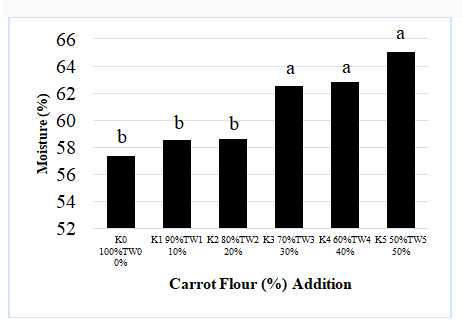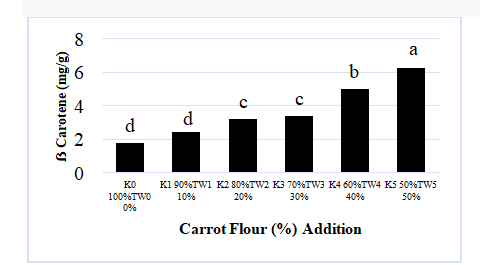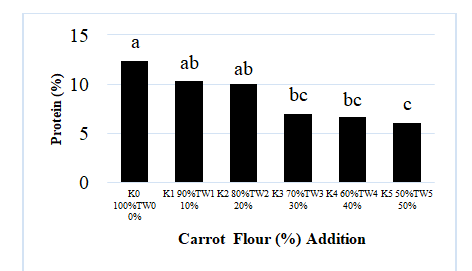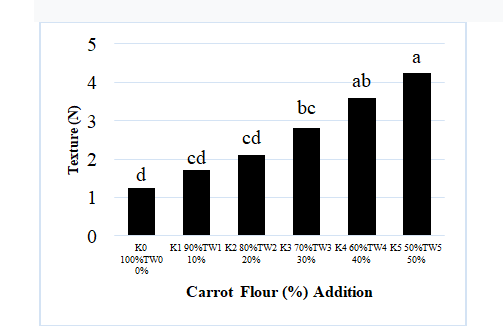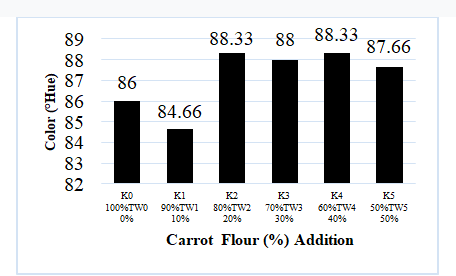Physicochemical and Organoleptic Value of Horse Meat Sausages based on the Level of Carrot Flour Substitution
- Alamsyah
- S.A. Kesturi
- D.N.A. Paramantha
- E. Basuki
- -106
- Oct 31, 2023
- Food Science
Physicochemical and Organoleptic Value of Horse Meat Sausages based on the Level of Carrot Flour Substitution
Alamsyah, S.A. Kesturi, D.N.A. Paramantha, E. Basuki *
Faculty of Food Technology and Agroindustry, University of Mataram, Indonesia
*Corresponding Author
DOI: https://doi.org/10.51244/IJRSI.2023.101009
Received: 15 September 2023; Revised: 27 September 2023; Accepted: 03 October 2023; Published: 31 October 2023
ABSTRACT
This research aims to determine the Physicochemical and Organoleptic Value of Horse Meat Sausages based on the level of carrot flour substitution. Experimental method with a Completely Randomized Design (CRD) with one factor, carrot flour substitution (10%; 20%; 30%;40% and 50%.) The parameters to be observed were chemical parameters (beta-carotene, ash, moisture and protein content), physical parameters (texture and color), as well as organoleptic parameters for hedonic and scoring methods (flavor, taste, color and texture). Observation data were analyzed using Analysis of Variance (ANOVA) at a significance level of 5% using Co-stat software. And continued with the Honestly Significant Difference (HSD) test at the same real level. The results show that the effect of the ratio of horse meat to carrot flour on sausage quality has a significantly different effect on ash content, water content, beta-carotene content, protein content, texture (N), hedonic organoleptic texture, flavor, taste, color and texture scoring. However, there was no significant difference in hedonic flavor, taste and color. Horse meat sausage and carrot flour with a ratio of 70%:30% is the best treatment which produces ash content of 5.28%, moisturer content of 62.53%, beta-carotene content of 3.41 mg/g, 7% texture 2.8 N, Color ( °Hue) 88 with the criteria of reddish yellow, flavor, taste, color that preferred by the panelists.
Keywords: Carrot Flour, Horse Meat, Sausage
INTRODUCTION
Meat is one of the livestock products that can hardly be separated from human life. Meat occupies an important position in the diet, because it tastes delicious and is the main source of nutrition, namely protein. Apart from containing protein, meat also contains amylase, lipase and protease compounds which can stimulate the digestive glands. Therefore, meat is used to stimulate appetite [10]. Horse meat is generally less popular with Indonesian people. This is because the fiber is rough, tough, and has a rancid aroma. However, horse meat has quite high nutritional value, so to make people choose to consume horse meat, it is best to process it into products such as corned beef, beef jerky, shredded meat, meatballs and sausages [9].Sausage is a food made from meat. Sausages have high nutritional content because they are made from ground meat which is a food source with high protein content. The filling ingredients usually used in making sausages is tapioca flour, sago flour and rice flour. According to FAO (2002) reported by Abrori [1], fillers are additional ingredients that function to increase the water holding capacity of the main sausage ingredient, namely horse meat. Flour containing starch is useful as a filler which can increase water holding capacity and improve fat emulsion so that it can produce good quality sausages. One food ingredient that contains starch and is nutritious as a filler for making sausages is carrots. Carrots have many health benefits, namely due to the nutritional content of carrots, namely carotenoids which are a source of provitamin A. The results of research on making carrot flour carried out by Deviurianty [11] show that carrot flour contains a calorie content of 42 Kcal, a water content of 90.4 g , phosphorus 28 mg, carbohydrates 9.30 g, calcium 33 mg, vitamin C 6 mg, protein 1.20 g, iron 0.66 mg, fat 0.30 g and vitamin B1 0.06 mg. The addition of carrot flour in making horse meat sausages is expected to add nutritional value, especially vitamin A to horse meat sausages and can be a natural coloring in horse meat sausages so that it can attract consumer interest. Based on research conducted by Effendy, et al [12] shows that the best treatment for making fish nuggets is with a concentration of 12% carrot flour with a beta-carotene content of 24.03 ppm and the panelists’ most favorable acceptance of color, taste, aroma and texture. Research conducted by Sidu [20] showed that the use of carrots in making skipjack tuna sausages gave panelists favorable results with the best treatment, namely 75% carrot: 25% sago starch which produced a water content of 57.46%, ash content of 2.52%, the texture and stickiness level is 4.95%, the hardness level is 37.48% and the color is 41.48 indicating red. The treatment design for making horse meat sausages with carrot flour refers to research conducted by Aji [3] using analog chicken meat for making sausages, but in this study horse meat was used as a substitute for chicken meat in order to add to the line of processed products from horse meat because it is known that horse meat is a source of important nutrients. The aim of this research was to determine the physico-chemical and organoleptic value of Horse meat sausages based on the level carrot flour substitution.
MATERIALS AND METHODS
The experimental design used in this research was a completely randomized design (CRD) with one factor, namely the substitution of carrot flour with the following treatment [3], namely (10%, 20%, 30% ,40%. 50%) with triplicates, so that 18 experimental samples were obtained. Data from chemical, physical and organoleptic observations were analyzed using Analysis of Variance (ANOVA) at the 5% level using Co-stat software. And continued by Honest Significant Difference [17].
Production of Carrot Flour
Fresh Danvers type carrots as raw materials which are bright orange in color, oval in shape with a pointed bottom part of the tuber, 10 cm to 12 cm long obtained from Sembalun Village. East Lombok Regency. Making carrot flour begins with a sorting process to avoid dirt, rotting carrots, and carrots that are infected with disease. After sorting, the carrots are immediately washed with running water then peeled to remove any remaining dirt and any unnecessary parts. The carrots are cut into 2 mm sizes which are useful for heat penetration during drying so that the drying time is faster. Next, the carrots are soaked in fine salt to prevent the browning process. The carrot pieces are blanched for 3 minutes at 85℃. Then it dried in an oven with a g temperature of 60oC for 24 hours. Dried carrot pieces are ground using a grinder until smooth. Finally the ground product is sifted using a 60 Mesh sieve to obtain carrot flour.
Production of horse meat sausages
Horse meat obtained from the market was cleaned and then weighed according to the overall sample requirements, namely 1350 g, then cut into small pieces and grinded. Horse meat is grinded for 2 minutes while adding ice cubes. The addition of ice cubes in this study was 6%. Secondly process of grinding the horse meat and ice cubes which are already smooth and mixed with carrot flour according to the treatment. The sausages was made based on the addition of carrot flour formulation namely 0%, 10%, 20%, 30%, 40% and 50%, and non meat ingredients ( 1% garlic, 1% salt, 1 % pepper, 2% sodium tripolyphosphate (STPP), 4% cooking oil) then ground using meat processor to form emulsion. The dough was put in casing and steamed for 30 minutes at 60oC. The cooked sausage was allowed to be at room temperature, for further analysis. The sausages was analyzed for physical, chemical and sensory value. The parameters to be observed were moisture content (SNI 01-2891-1992), ash content (SNI 01-2891-1992), protein content [22], beta-carotene content, color [5], texture profile analysiss using Texture Analyzer and Sensory evaluation was conducted on all treatment using trained panel composed of individuals from the Faculty [16].
RESULTS AND DISCUSSION
1. Ash content
Ash content is an inorganic component that comes from the residue from burning food and determined based on weight loss at the end point of combustion is stopped before decomposition of the ash occurs, and finding out how much minerals contained in the sample. The function of ash content is to know that the higher the ash content, the worse the quality of the food [23].
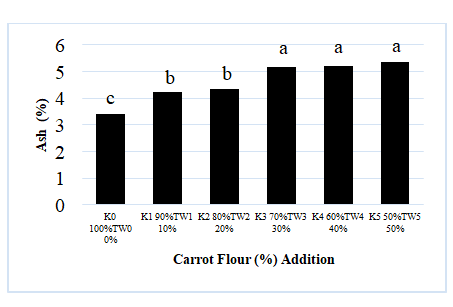
Fig.1. The effect of Ratio of Horse Meat and Carrot Flour to the Ash Content of Sausages.
The lower the concentration of horse meat and the higher the concentration of carrot flour have significantly different effects on the ash content of sausages and the higher the concentration of carrot flour causes the ash content of sausages to increase. The difference in ash content in the treatments was due to the higher addition of carrot flour in each treatment. This agree with Rosalinda [19] showed that the higher the addition of carrot flour causes the ash content in horse meat sausages increase. This is because carrot flour contains a higher ash content than horse meat. The ash content in carrot flour based on research conducted by Tjahjadi [24] shows 5.6% in 100 g, while the ash content in horse meat in 100 g based on Bulkaini [9] is 0.9 g, so it can be concluded that increasing the concentration of ingredients containing higher ash content will increase the ash content of product.
2. Moisture content
Moisture is an important component in food because water can affect the appearance, texture and taste of food. Moisture content is important to analyze because water content determines the freshness and durability of food ingredients and is also a quality parameter of a product. The moisture measured is the difference between the constant weight of the material before drying and the weight of the material after drying and is expressed in percent (%) [28].
Fig.2. The effect of Ratio of Horse Meat and Carrot Flour to the Moisture of Sausages.
The concentration of horse meat and the higher the concentration of carrot flour have significantly different effects on the water content of sausages and the higher the concentration of carrot flour causes the water content of sausages to increase. The lowest water content was in the controlled treatment, namely 57.3% and the highest water content was in the 50 % carrot flour, namely 65.01%. The difference in sausage moisture content is associated with the capability of the dough to bind water, and this depends on the type of gelatin with its hydroplilic properties and ability to form gel [1]. This is agree with Anggraini et al [2] showing that the higher the addition of mocaf, the higher the water content of African catfish sausages. This is also in line with Febriyanti [13] showing that the higher the concentration of carrot paste added, the more water content in mullet fish sausages increases. The difference in water content of the treatments was caused by the higher addition of carrot flour in each treatment. According to Ariyani (2010), increasing the concentration of filler causes the water content of the sausage to increase, because more water will be absorbed. The maximum water content in meat sausages which has been regulated by the Indonesian National Standard (SNI 3820-2015) is a maximum of 67%, so the moisture content of the sausages has met the quality standards.
3. Beta-carotene levels
Beta-carotene is a source of provitamin A found in animal foods in the form of meat, liver and eggs. Vitamin A is not found in plant foods, however, plants are able to form or synthesize carotenoid compounds which are precursors of vitamin A. These vitamin A precursors are yellow to red pigments that can be found in leaves or fruit and vegetables [4]. The effect of the ratio of horse meat and carrot flour on the beta-carotene content of sausages can be seen in Figure 3.
Fig.3. The effect of Ratio of Horse Meat and Carrot flour to the ẞ Carotene of Sausages.
The concentration of horse meat and the higher the concentration of carrot flour have significantly different effects on the beta-carotene content of sausages. The lower the concentration of horse meat and the higher the concentration of carrot flour caused the sausage beta-carotene content to increase. The difference in beta-carotene levels in each treatment was due to the higher addition of carrot flour in each treatment. Carrot flour contains beta-croten, namely 11.94 mg/g [24]. Meanwhile, based on Bulkaini [9], 100 g of fresh horse meat does not contain beta-carotene, so the higher the concentration of carrot flour added, the higher the beta-carotene content in horse meat sausages. This is in line with research conducted by Effendy [12] showing that the more carrot flour added resulted in Increase the beta-carotene content of tilapia fish nuggets .
4. Protein levels
Protein in food is a source of nutrition that acts as a source of amino acids for organisms that are unable to form amino acids. The protein content found in food varies, both in quantity and type, which can provide important functional properties in forming the characteristics of food products [5].
Fig.4. The effect of Ratio of Horse Meat and Carrot Powder to the Protein Content of Sausages.
The lower concentration of horse meat and the higher concentration of carrot flour have significantly different effects on sausage protein content. The lower the concentration of horse meat and the higher the concentration of carrot flour, the protein content of the sausage decreases. This is because horse meat contains high protein. According to Kadir [15] fresh horse meat contains 18.1% protein, so, as the concentration of horse meat decreases, the protein content of sausages decreases with each treatment. Meanwhile, carrot flour contains low protein. According to Utami [26] carrot flour has a protein content of 4.57%, so it is unable to increase the protein content in sausages even though the concentration of carrot flour in each treatment increases. This is in line with research conducted by Ratnasari [17] showing that the lower the concentration of tempeh and the higher the concentration of carrot flour, the protein content of tempeh nuggets decreases.
5. Texture
Texture is meat charachteristic related to coarseness of meat fiber. Texture is the state of a product that can be felt so that it becomes a benchmark for a product to identify whether a product is solid or soft [25]. The effect of the ratio of horse meat and carrot flour on the texture in Newton units (N) of sausages can be seen in Figure 5.
Fig.5. The effect of Ratio of Horse Meat and Carrot Powder to the texture of Sausages.
The Figures showed that lower concentration of horse meat and the higher concentration of carrot flour have significantly different effects on the texture (N) of sausages. The lower the concentration of horse meat and the higher the concentration of carrot flour, the denser the texture (N) of the sausage. The difference in texture (N) in sausages was caused by the higher concentration of carrot flour added in each treatment. Carrot flour functions as a filler in making sausages, so that as the concentration of carrot flour increases, the texture of the sausage becomes denser. This agree with Ulya [25] showing that the higher the concentration of arrowroot starch in making horse meat meatballs, the denser the texture of the horse meat meatballs produced. Fillers in the form of carrot flour in addition to being able to bind water when heated had a rubbery property such as gelatin so resulting processed product will be suppler The factor increasing the hardness value can be caused by the starch content in carrot flour. Based on research by [13], it shows that the amylose content of carrot flour is 26.60%. Therefore, the higher the concentration of carrot flour added, the denser the texture of the horse meat sausage will be.
6. Color (°Hue)
The color of a food can be identified qualitatively and quantitatively by looking at the color. Meanwhile, quantitatively, namely based on the value shown by a tool. The tool used to test the color of food is a colorimeter. The working principle of this colorimeter is based on the reflection of the color produced by the sample [25]. The effect of the ratio of horse meat and carrot flour on the color (°Hue) of sausages can be seen in Figure 6
Fig. 6. The effect of Ratio of Horse Meat and Carrot Powder to the Color Hue of Sausages.
Figure 6 shows that the lower the concentration of horse meat and the higher the concentration of carrot flour have no significantly different effect on the color (°Hue) of the horse meat sausage produced. The lower concentration of horse meat and the higher concentration of carrot flour have no effect on the color (°Hue) detected by the colorimeter. The color (°Hue) of the horse meat sausage produced is 84.66-88.33 with a reddish yellow color index. This can be caused by a slight difference in the concentration of carrot flour in each treatment, resulting in almost the same color in the horse meat sausages produced, so that a slight color difference causes the same color in all treatments as read by the colorimeter. This is in line with research showing that the higher the concentration of carrot flour produces results that are not significantly different in the level of brightness (L), level of redness (a), and level of yellowness (b) of the tempeh nuggets produced, so that The °Hue value of the tempeh nuggets produced in this study also did not show significantly different results [17].
7. Organoleptic properties of Sausages
Flavor is a parameter that can be identified by the sense of smell which is one of the factors supporting consumer attraction towards a food product. Flavors is complex and inter-related sensation of meat products and involved smell, taste, temperature and pH. There was not any different in the flavor of horsemeat sausages with addition of carrot flour. The lower concentration of horse meat and the higher concentration of carrot flour had no effect on the panelists’ preference for the aroma of sausage. The average panelists’ liking score for the aroma of sausage ranged from 2.95-3.3 with the criteria being somewhat like it. The difference in the level of liking affects the subjectivity of the panelists in assessing a food product Aroma is a parameter that can be identified by the sense of smell which is one of the factors supporting consumer attraction towards a food product. Aroma is a complex and interrelated sensation of meat products.
Table 1. Organoleptic Method (H) and Scoring (S) of Sausages Horse Meat added with Carrot Flour *
| Horse Meat: Carrot Flour (%) | Parameter | |||||||
| Aroma | Taste | Color | Texture | |||||
| H | S | H | S | H | S | H | S | |
| 100%: 0% | 3,35 | 1c | 3,2 | 1c | 3,2 | 3,7b | 3,1ab | 2,6b |
| 90%:10% | 3,5 | 2,6b | 3,4 | 2,65b | 3,3 | 3,75b | 3,35ab | 3,35a |
| 80%:20% | 3,15 | 3,05ab | 3 | 3,05b | 3,5 | 3,95b | 3,15b | 3,45a |
| 70%:30% | 3,1 | 3,25ab | 2,9 | 3,15ab | 3,3 | 4,15ab | 4a | 3,6a |
| 60%:40% | 2,95 | 3,45ab | 2,7 | 3,3ab | 3,15 | 4,3ab | 3,25b | 3,8a |
| 50%:50% | 3,1 | 3.55a | 2,8 | 3,95a | 3,15 | 4,8a | 3,05b | 4a |
| HSD | 0,88 | 0,88 | 0,69 | 0,68 | 0,69 | |||
* Different superscripts at the same row indicated significant differences (P<0.05)
There was any different in the aroma and taste and color of horse meat sausage with addition of carrot flour. The lower the concentration of horse meat and the higher the concentration of carrot flour caused differences in the aroma and taste scoring of the sausages that were perceived by the panelists. This could be caused by the horse meat concentration being 100% and the carrot flour concentration being 0% so the meat aroma was stronger, whereas the 10 % addition of flour showed the criteria for a strong meat aroma, strong carrot aroma. This could be due to the ratio of horse meat and flour which is greater than carrot flour, namely 90%:10% so that the aroma of horse meat and carrot flour can be clearly differentiated by the panelists, therefore causing the panelists to judge the aroma of horse meat and carrot flour to be both are strong. Meanwhile, treatments of 20 to 50 % showed the criteria for a rather strong meat aroma, rather strong carrot aroma. This is in line with research showing that the higher the concentration of tempeh and the lower the concentration of carrot flour, the more significant the aroma of the tempeh nuggets produced [17]. The lower the concentration of tempeh, the more nuggets will be produced with a very weak typical tempeh aroma. Taste is one of the important factors in determining the taste of food. The taste of a food is a factor that also determines consumer acceptance. Taste is influenced by several factors, namely chemical compounds, temperature, concentration and interactions with other taste components [28] The influence of the ratio of horse meat and carrot flour on the organoleptic taste of the hedonic sausage method can be seen in Table 1. The lower concentration of horse meat and the higher concentration of carrot flour had no effect on the panelists’ preference for the aroma of sausage. The average panelists’ liking score for the aroma of sausage ranged from 2.7-3.4 with the criteria of not liking it to somewhat liking it. This depends on the subjectivity of different panelists in assessing a product based on their level of liking. This is in accordance with the opinion of Rezky et al [18] that the taste is influenced by the basic ingredients and additional ingredients that are mixed into the nugget mixture with a delicious taste. According to Winarno [28], determining the quality of food ingredients generally depends on several factors, including taste, color, texture and nutritional value. Before these factors are considered visually color appears first and is sometimes very decisive. Apart from being a factor that determines quality, color also shows whether the mixing or processing has been done well or correctly. The influence of the ratio of horse meat and carrot flour on the organoleptic color of the sausage hedonic method can be seen in table 1. The average panelists’ liking score for the aroma of sausage ranged from 3.15-3.5 with the criteria being somewhat like it. The difference in the level of preference is due to differences in panelists’ subjectivity in assessing a food product. Meanwhile, the influence of the ratio of horse meat and carrot flour on the organoleptic color of the sausage scoring method can be seen in table1. Determining the quality of food ingredients generally depends on several factors, including taste, color, texture and nutritional value [28]. Before these factors are considered visually, color appears first and is sometimes very decisive. Apart from being a factor that determines quality, color also shows whether the mixing or processing has been done well or correctly. Table 1 shows that the lower the concentration of horse meat and the higher the concentration of carrot flour have no significantly different effect on the organoleptic color of the sausage hedonic method. The lower the concentration of horse meat and the higher the concentration of carrot flour caused an increase in the color of the sausage seen by the panelists. Addition of 10 % to 20 % of carrot flour show an orange color. This can be caused by horse meat which is red in color and mixed with carrot flour which is light orange in color with a higher concentration of horse meat compared to the concentration of carrot flour, so that the color produced by the sausage becomes orange. Meanwhile, treatments of 30 to 50 % of carrot flour howed a light brown color. This is because the mixing of horse meat and carrot flour is not much different, so that the three treatments produce the same color. This is in line with research conducted by Atika [8] indicated that the higher the concentration of honey added, the color of the resulting horse meat meatballs becomes more intense. The source of color in the horse meat sausages produced in this research is the natural red color of horse meat and the color of carrot flour which is used as a filler. Carrots are known to contain beta-carotene which functions as an orange, red-orange and yellow pigment [21;27]. When the ingredients are mixed between horse meat and carrot flour, it causes the color of the resulting horse meat sausage to become more intense. This is in line with research showing that the higher the concentration of added tapioca flour and the lower the concentration of horse meat causes the color of the horse meat sausage to become browner [9]. Carrot flour will contribute a brown color to the sausage because some of the starch will react with the proteins in horse meat, so the higher the concentration of carrot flour added, the browner the color of the horse meat sausage will be. Texture is the state of a product that can be felt so that it becomes a benchmark for a product to identify whether a product is solid or soft [25]. Table1 shows that the lower the concentration of horse meat and the higher the concentration of carrot flour have no significantly different effect on the organoleptic texture of the sausage hedonic method. The lower the concentration of horse meat and the higher the concentration of carrot flour had no effect on the panelists’ preferences for the texture of the sausage produced. The average panelists’ liking score for the aroma of sausage ranged from 3.05-4 with the criteria being somewhat like it to like it.
Texture (Scoring)
Texture is the state of a product that can be felt so that it becomes a benchmark for a product to identify whether a product is solid or soft [25]. The lower the concentration of horse meat and the higher the concentration of carrot flour have significantly different effects on the texture of the sausage. The lower the concentration of horse meat and the higher the concentration of carrot flour, the denser the texture of the sausage produced. The controlled treatment showed that the sausage texture was very not dense. This is because there is no addition of carrot flour in this treatment, resulting in a soft texture. The addition of carrot flour in making sausages functions as a filler to produce a soft texture that is preferred by the panelists based on commercial sausages in general. Carrot flour was not added to this treatment because this treatment functioned as a control treatment, so that it could be used as a comparison with other treatments where carrot flour was added. Meanwhile, treatments of 10 to 50 % flour added showed a sausage texture with slightly dense. This could be because the ratio of horse meat and carrot flour is still within reasonable limits so as to produce sausages with the desired texture. Meanwhile, the 50 % adding flour showed a sausage texture with solid criteria. This could be due to the same ratio of horse meat and carrot flour, namely 50%:50%, which is thought to produce a denser sausage texture. The more concentration of carrot flour added, the denser the texture of the sausage. This is because carrot flour functions as a filler in making sausages. This is in line with research showing that the higher the concentration of tapioca flour and the lower the concentration of horse meat, the less soft the sausage texture will be [9]. According to Aristawati et al [6] flour functions to improve or stabilize emulsions, increase water holding capacity, reduce shrinkage, increase weight.
CONCLUSION
The ratio of horse meat and carrot flour to horse meat sausages has a significantly different effect on ash content, water content, beta-carotene content, protein content, texture (N), organoleptic aroma and taste. , color, texture scoring, and hedonic organoleptic texture but not significantly different from color (°Hue) and hedonic organoleptic aroma, taste, and color. The lower the concentration of horse meat and the higher the concentration of carrot flour, the higher the ash content, water content, beta-carotene content, protein content and the denser the texture (N). Treatment with a ratio of horse meat and carrot flour K370%TW330% is the best treatment which produces ash content of 5.28%, water content of 62.53%, beta-carotene content of 3.41 mg/g, 7% texture 2.8 N, Color ( °Hue) 88 with the criteria of reddish yellow, aroma, taste, color that preferred by the panelists.
REFERENCES
- Abrori, F. 2003. Effect of the proportion of fish meat and tapioca flour on the quality of snakehead fish sausages. Thesis. Faculty of Fisheries, Brawijaya University, Malang.
- Anggraini R. D. Tejasari, and Yhulia P. 2016. Physical Characteristics, Nutritional Value, and Sensory Quality of Dumbo Catfish (Clarias gariepinus) Sausages with Variations in Type and Concentration of Filling Ingredients. Agrotechnology Journal. 10(1): 25-24.
- Aji, B.S. 2019. Chicken Sausage Formulation with Analog Meat Substitution and Business Development Analysis using the Business Model Canvas Approach. Thesis. Faculty of Agricultural Technology. University of Jember.
- Almatsier, S. 2001. Basic Principles of Nutrition Science. Gramedia Pustaka Utama. Jakarta.
- Andarwulan, N., Kusnandar, F., and Herawati, D. 2011. Food Analysis. Dian Rakyat. Jakarta.
- Aristawati RW, Atmaka W, Muhammad DRA. 2013. Substitution for Tapioca Flour (Manihot esculenta) in Making Takoyaki. Journal of Food Technoscience 2(1): 56-65.
- Ariyani, N. 2010. Formulation of ready-to-use mixed flour made from tapioca-mocaf with the addition of maltodextrin and its application as coating flour for spinach chips. Thesis. Faculty of Agriculture, Jenderal Soedirman University. Purwokerto.
- Atika, I. 2018. Effect of Honey Powder Addition Level on Organoleptic Quality, Antioxidants and Fat Content of Horse Meat Meatballs. Thesis. Faculty of Animal Husbandry. Brawijaya University.
- Bulkaini, Djoko K., and Muhammad Y. 2019. Physical Characteristics and Organoleptic Value of Horse Meat Sausages Based on the Level of Tapioca Starch Substitution. Veterinary Journal. 20(4): 548-557.
- Bulkaini, Samiadi, Kisworo and Hakim. 2014. Production of Beef-Based Functional Food with the Addition of Vegetable Ingredients, Green Bean Flour to Improve Sausage Quality. Faculty of Animal Husbandry. Mataram University.
- Deviurianty, F. 2011. Process of Making Carrot Flour. http://www.bps.gp.id/tab _sub/view.php?at= 3&tabel =1®ister=1&is_subyek= 55¬ab=65 (Accessed 12 March 2023).
- Effendy, A. N. W., et al. 2022. Organoleptic and Beta-carotene Analysis of Tilapia Fish Nuggets (Oreochromis sp.) with the Addition of Carrot (Daucus carota L.) flour. Fishtech Journal. 11(1): 140-153.
- Febriyanti, V., Elly Y.S., and Sri H. 2013. The Effect of Substituting Carrot Paste and Tapioca Flour as Filling Materials on the Physicochemical and Sensory Properties of Mullet Fish Sausages. Thesis. Fac.of Agric.. Semarang University.
- Hanafiah and Ali, K. 2004. Theory and Application Experiment Plan. Jakarta: Raja Grafindo Persada.
- Kadir, S. 2011. Consumer Preferences for Processed Horse Meat Products in Makassar. Agibusiness Journal .10(3): 49-57.
- Rahayu, W. P. 1998. Sensory Practical Analyse. IPB University Bogor
- Ratnasari, D.A. 2023. Effect of Adding Carrot Flour on the Physicochemical and Organoleptic Properties of Tempeh Nuggets. Thesis. Faculty of Agriculture. Muhammadiyah University of Malang.
- Rezky, Awaliah SY, and Sukainah A. 2017. Analysis of the physicochemical properties of crab nuggets (Portunus pelagicus) with various filling materials. Journal of Agricultural Technology Education. 3(2): 13- 20.
- Rosalinda, S. 2023. The Effect of Adding Carrot (Daucus carotaL.) Flour on the Chemical and Hedonic Quality of Goat Meat Nuggets. Thesis. Faculty of Animal Husbandry. Mataram University.
- Sidu, S. Engelen, A., and Hasan A.A. 2018. Skipjack Fish Sausage (Katsuwonus pelamis L.)with the Addition of Carrots (Daucus carota) and Sago Starch (Metroxylon sp). Journal of Science and Agritechnology. 2(2): 1-10.
- Singal, Y. C. 2013. Effect of adding carrot flour (Daucus carota L.) to making snakehead fish (Ophiocephalus striatus) sausages. Unsrat Journal. 3(6): 1-9.
- Sudarmadji, S., B.Haryono and Suhardi . 2010. Prosedur Analisa untuk Bahan Makanan dan Pertanian. Yogyakarta : Liberty
- Tahar, N., M. Fitrah, and Nur, A. M. D. 2017. Determination of Protein Content in Flying Fish Meat (Hyrundicthys oxycephalus) as a Flour Substitute in Biscuit Formulation. Journal of Pharmacy. 5(4): 251-257.
- Tjahjadi and Sacharissa F. 2013. Physical and Chemical Characteristics of Carrot Flour. Thesis Parahyangan Catholic University.
- Ulya, B.I.K. 2022. Effect of Porang (Amorphophallus muelleri Blume) Glucomannan Flour Concentration on the Functional Properties of Carrot Jelly Drinks. Thesis. Faculty of Food Technology and Agroindustry, University of Mataram. Mataram.
- Utami, S. I. 2015. Effect of Carrot (Daucus carota L.) Flour Substitution on Organoleptic Quality and Beta-carotene Content of Dodol. Padang Health Polytechnic.
- Vega, P. J., M. O. Balaban, C.A. Sims, S.F O’keefe and J.A. Cornell. 1996. Supercritical Carbon Dioxide Extraction Efficiency for Carotenes from Carots by RSM. Journal of Food Science. 61(4): 757-759.
- Winarno, F., G. 1997. Food Chemistry and Nutrition . Gramedia Pusaka Utama. Jakarta.


